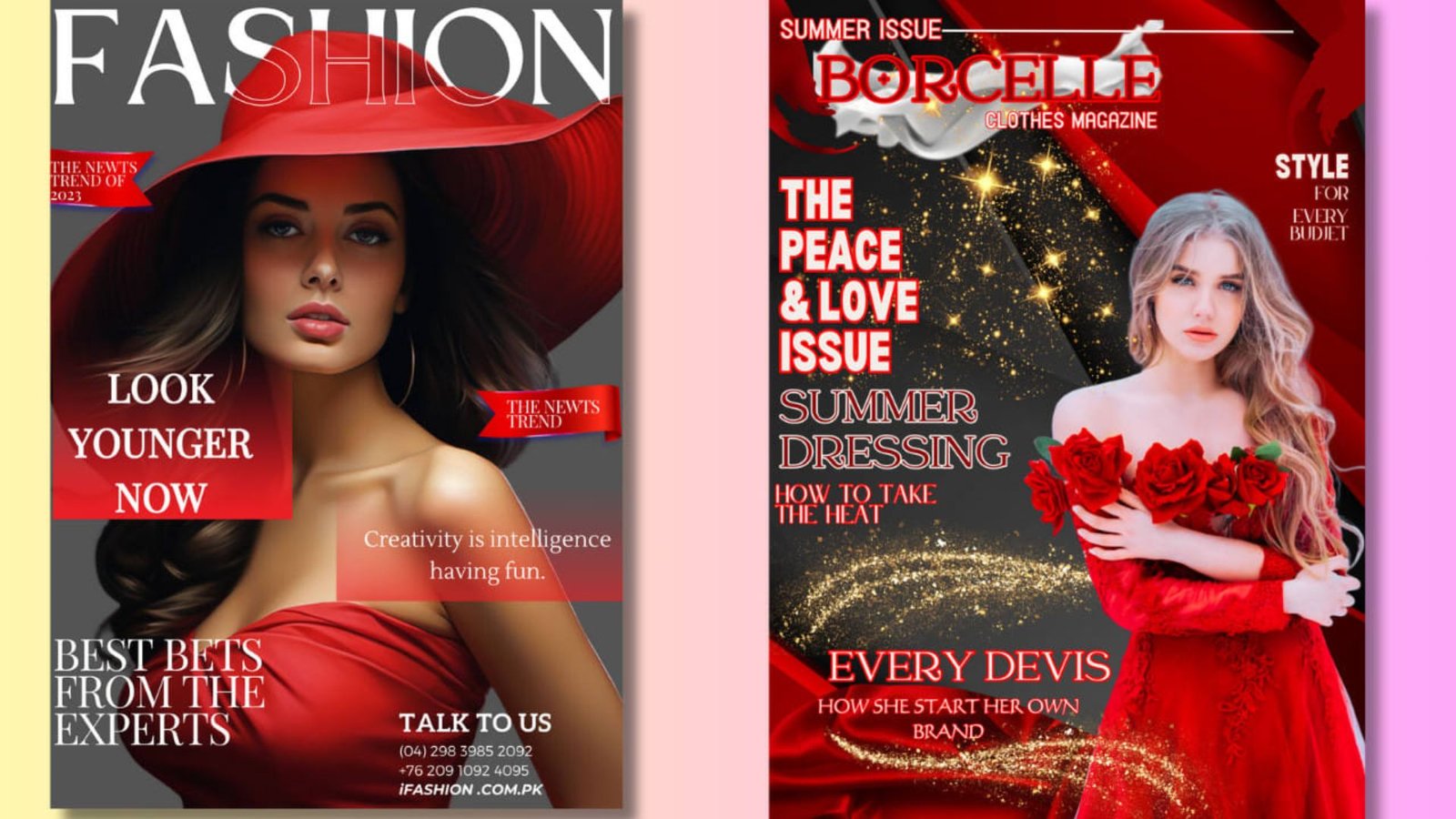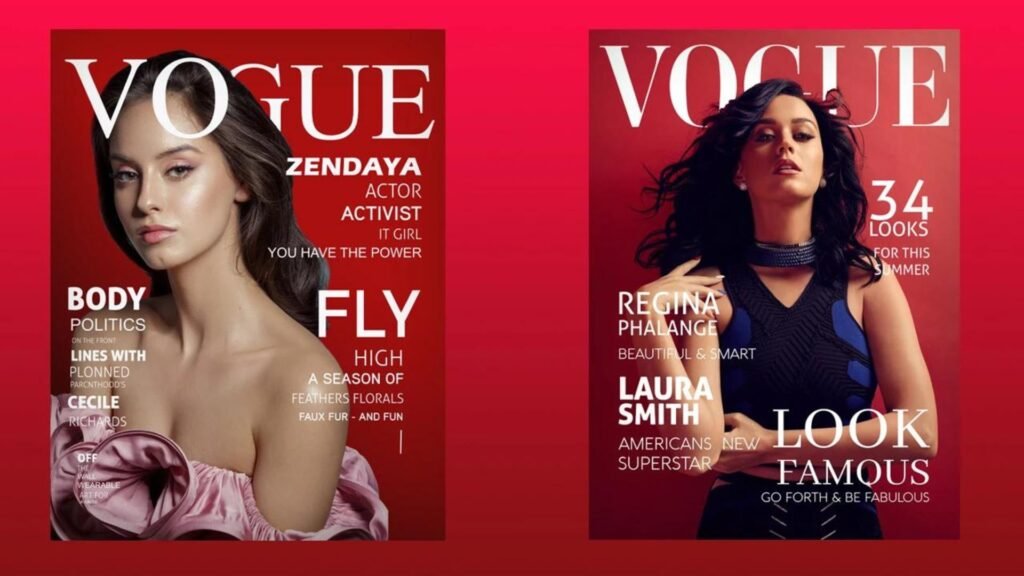Fashion magazine covers serve as the first impression for readers, enticing them to delve into the world of style within the pages. Crafting an eye-catching cover involves a blend of creativity, design expertise, and an understanding of current trends. In this guide, we’ll walk through the essential steps to create captivating fashion magazine covers that leave a lasting impact.

Understanding Your Target Audience
Before diving into the design process, it’s crucial to have a clear understanding of your target audience. Knowing your audience sets the tone for the cover’s design elements.
Grasping the Latest Fashion Trends
Stay abreast of the latest fashion trends to infuse freshness and relevance into your cover. Whether it’s colours, patterns, or typography, aligning your design with current trends ensures your magazine remains visually appealing and resonates with your readership.
Choosing a Compelling Cover Image
Selecting the right cover image is pivotal. It should not only showcase a key element of your magazine’s content but also evoke curiosity. Whether it’s a striking fashion photograph or an artfully arranged ensemble, the cover image serves as the visual focal point.
Headline Placement and Typography
Place your magazine’s headline strategically to complement the cover image. Experiment with font styles that align with your magazine’s branding. Ensure readability, even from a distance, and consider the hierarchy of text elements to guide the reader’s eye seamlessly.
Play with Colors and Contrast
Use a colour palette that harmonizes with the overall theme of your magazine. Bold, contrasting colours can make key elements pop and draw attention. Experiment with colour combinations that evoke the desired emotional response from your audience.
Incorporating Creative Layouts
Break away from conventional layouts and experiment with creative arrangements. Consider asymmetrical designs, unconventional placements, or overlaying text on images. A well-thought-out layout can elevate the visual interest of your cover.
Balancing Elements for Harmony
Achieving a balance among various elements is crucial for a harmonious design. Ensure that the image, text, and any additional graphics complement each other rather than competing for attention. Strive for a visually pleasing and cohesive composition.
Test for Impact at Various Sizes
Your magazine cover will appear in various contexts, from newsstands to online platforms. Test the visual impact of your design at different sizes to ensure it remains captivating and legible in all scenarios.
Embracing Minimalism or Boldness
Decide on the overall aesthetic of your cover—whether it leans towards minimalism, featuring clean lines and simplicity, or embraces boldness with vibrant colours and intricate details. Consistency in your design approach establishes a recognizable brand identity.
Adding Finishing Touches
Consider adding finishing touches such as subtle textures, gradients, or overlays to enhance the overall visual appeal. These subtle details can elevate your cover design and add a touch of sophistication.
11. Dynamic Composition: Movement and Flow
Experiment with dynamic compositions that create a sense of movement and flow. Whether through the positioning of models or the use of diagonal lines, a dynamic layout adds energy to your cover design.
12. Iconic Logos: Brand Recognition
If your fashion magazine has a recognizable logo, strategically incorporate it into the cover design. A well-placed logo enhances brand recognition and contributes to the overall aesthetic.
13. Seasonal Themes: Embracing Trends
Tailor your cover design to reflect seasonal themes and trends. Whether it’s spring florals, winter warmth, or summer vibrancy, aligning your cover with the current season enhances relatability.
14. Interactive Elements
Introduce interactive elements such as QR codes or augmented reality features. These can lead readers to exclusive content, behind-the-scenes footage, or interactive experiences, creating a multisensory engagement.
15. Social Media Integration
Consider integrating social media elements into your cover design. This could involve featuring Instagram handles, and hashtags, or even incorporating user-generated content from social platforms to foster community engagement.
16. Innovative Typography
Push the boundaries with typography by exploring 3D effects, creative text placements, or unique font choices. Innovative typography can add a layer of sophistication and modernity to your cover.
17. Collaborative Covers
Collaborate with influencers, fashion designers, or other industry personalities for special edition covers. This not only diversifies your cover content but also leverages the followers of those featured.
18. Thematic Consistency
Consider creating a series of covers with a consistent theme. This can be particularly effective for special editions, anniversaries, or collections, creating a visually cohesive narrative.
19. Texture and Material Play
Incorporate tactile elements into your cover design, such as embossing, foil stamping, or textured paper. These subtle tactile details can enhance the sensory experience for your readers.
20. Typography as Art
Treat typography as art by turning letterforms into visual elements. Experiment with fonts that double as graphic elements, intertwining with the overall design for a unique and artistic cover.
Conclusion
Crafting eye-catching fashion magazine covers is both an art and a strategic endeavour. By understanding your audience, staying updated on trends, and employing creative design techniques, you can create covers that not only attract attention but also engage readers and entice them to explore the exciting world within your magazine’s pages. Happy designing!

